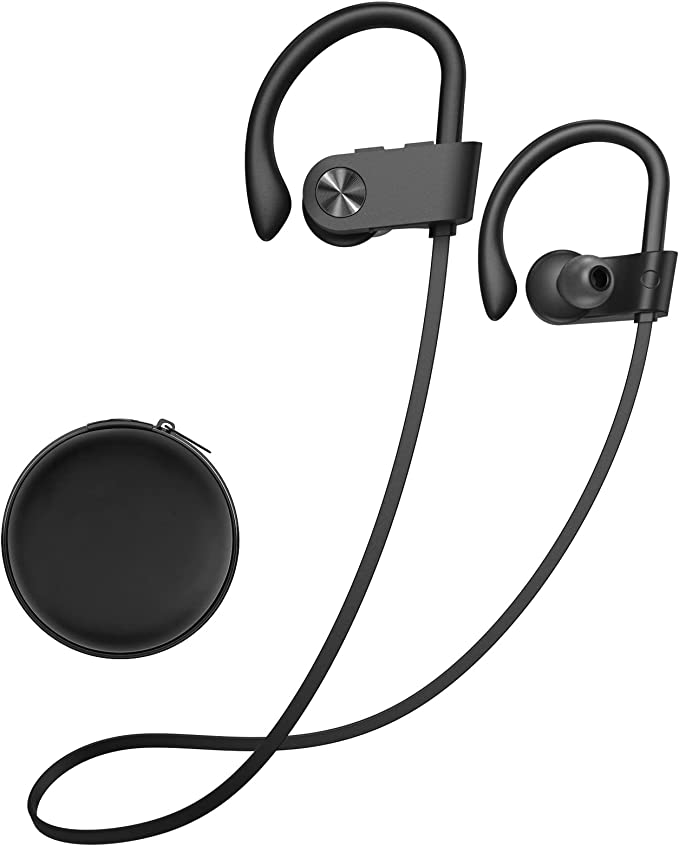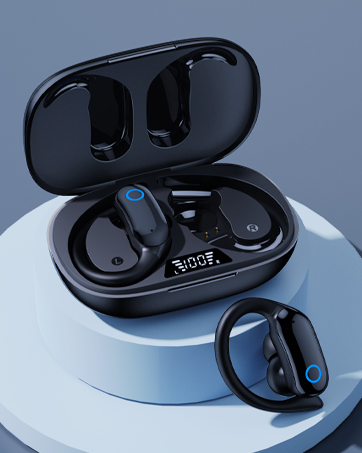There’s an almost universal truth among those of us who blend fitness with daily life: music makes movement better. That pounding beat can transform a grueling run into a rhythmic dance, a monotonous gym session into an energizing escape. But finding the right audio companion for these active moments? That’s often where the friction lies. Earbuds slip out mid-stride, batteries die halfway through a playlist, and the ever-present fear of sweat or sudden rain looms large.
Enter the myriad of wireless sports headphones vying for a spot in our ears, like the POIUZET U8I. While countless options exist, exploring the technology packed into a specific model like this offers a fantastic window into the clever engineering designed to overcome these common active-lifestyle frustrations. Let’s put on our tech-detective hats and peel back the layers, moving beyond marketing terms to understand the science and design choices that aim to make these earbuds a reliable partner for your workouts.

Crafting Your Personal Sound Bubble: The Sonic Heart
At its core, any headphone is about sound. The U8I promises “Crisp High Fidelity Sound” with “HiFi Bass Stereo.” Lofty terms, but what’s happening inside? The primary movers are almost certainly dynamic drivers. Imagine a miniature version of a traditional loudspeaker cone or a tiny drum skin. An electrical signal, carrying the music, energizes a small electromagnet attached to a voice coil, causing a lightweight diaphragm to vibrate rapidly back and forth. These vibrations push the air, creating the pressure waves our ears interpret as sound. The quality of these components—the magnet strength, the diaphragm material, the precision of the coil—all influence the clarity and range of sounds produced.
The term “HiFi” here likely signifies an aspiration towards faithful sound reproduction, aiming for a balanced output across bass, mids, and highs, rather than overly boosted bass that can muddy the details – crucial for hearing both the driving beat and the subtle nuances in music or podcasts during exercise. Orchestrating this sonic delivery and managing the wireless signal often falls to a dedicated processing chip, like the CSR chip mentioned in the product description. Think of it as the conductor of this tiny audio orchestra, ensuring the Bluetooth signal is translated effectively into the electrical pulses that drive the speakers.
Cutting the Cord, Keeping the Connection: The Wireless Promise
The liberation of wireless audio is undeniable, especially during activities where flailing cables are a hazard. The U8I employs Bluetooth 5.0, a significant step in the evolution of this ubiquitous short-range wireless standard. But what does “5.0” really mean for you? Compared to its predecessors, Bluetooth 5.0 generally offers tangible improvements. Think of the data pathway between your phone and the earbuds as a highway. Bluetooth 5.0 effectively widens these lanes and smooths the traffic flow, leading to a more stable connection with fewer frustrating dropouts or stutters, particularly important when your body is moving and potentially interfering with the signal.
It also streamlines the initial handshake process, enabling the “fast connect to previously paired devices” mentioned. Furthermore, Bluetooth 5.0 incorporates aspects of Bluetooth Low Energy (BLE), potentially contributing to better power efficiency, helping stretch that battery life further. It’s about reducing friction – less time spent fiddling with connections, more time immersed in your activity.
“Can You Hear Me Now?” – Decoding Clear Calls on the Move
Taking calls mid-workout is a common reality. The U8I features a CVC 6.0 Noise-Cancelling Microphone. Now, this is a critical point of understanding: CVC stands for Clear Voice Capture, and it’s fundamentally different from the Active Noise Cancellation (ANC) you might find in higher-end headphones designed to silence the world around you. CVC technology focuses specifically on the microphone’s input.
Imagine you’re jogging on a breezy day and need to take a call. CVC algorithms work cleverly to identify your voice pattern while simultaneously recognizing and digitally reducing steady background noise – like that wind hiss or ambient traffic hum – before the signal is transmitted to the person you’re calling. It’s like giving the microphone a highly focused spotlight, ensuring your voice cuts through the surrounding noise more clearly for the listener on the other end. So, while it won’t make the world quieter for you, it significantly improves the chances that your caller can understand you without asking you to repeat yourself constantly – a vital feature for clear communication during active moments.

The Unseen Shield: Braving Sweat, Rain, and the Elements
Sweat is the badge of honor for a good workout, but it’s Kryptonite to sensitive electronics. This is where the IPX7 waterproof rating comes into play. Let’s decode that “IP” code: IP stands for Ingress Protection. The ‘X’ means the device hasn’t been specifically rated against dust ingress, but the ‘7’ is the crucial part for water. According to the international standard (IEC 60529), a ‘7’ rating signifies protection against the effects of temporary immersion in water, typically defined as up to 1 meter deep for 30 minutes.
However, for earbuds, the practical implication isn’t about swimming. It’s about robust protection against heavy sweat, splashes, and being caught in the rain. How is this achieved? It usually involves a combination of a tightly sealed outer shell and, as mentioned for the U8I, an interior nano-coating. Picture this: a microscopically thin, invisible layer applied to the internal circuitry. This layer is hydrophobic, meaning it repels water molecules, much like the waxy surface of a lotus leaf causes water to bead up and roll off. This “unseen shield” provides crucial peace of mind, allowing you to focus on your workout, not on babying your gear.

Endurance Athletes: Matching Your Stamina, Watt for Watt
A dead battery mid-session can instantly deflate motivation. The U8I houses a lithium polymer (Li-Po) battery, the modern standard for most portable electronics due to its ability to pack significant energy into a small, lightweight form factor. The advertised 12 hours of playtime is quite respectable for earbuds of this type. Contextualize that: it’s enough to cover several long workouts, a full day of intermittent listening, or even a marathon run with time to spare.
This endurance isn’t just about battery capacity; it’s also a testament to the power efficiency potentially offered by components like the Bluetooth 5.0 chip and overall system design. When the battery does eventually deplete, the relatively quick 1-2 hour recharge time minimizes downtime, ensuring the headphones are ready to go again when you are. It’s about providing the stamina to match your own, keeping the soundtrack playing as long as you keep moving.
The Ergonomic Embrace: Finding Stability and Comfort in Motion
Sound quality and battery life mean little if the headphones won’t stay comfortably in your ears during vigorous activity. This is where ergonomic design becomes paramount. The U8I utilizes ear hooks, a common and effective solution for sports headphones. These flexible hooks loop over the top of your ear, using basic physics – leverage and counter-balance – to provide a secure anchor point, drastically reducing the chances of the earbuds dislodging during jumps, sprints, or other dynamic movements.
Complementing the hooks are the multiple eartip sizes (XS, S, M, L), typically made from soft silicone. Finding the right size is crucial for two reasons. First, comfort: an ill-fitting tip can cause pressure or irritation over time. Second, the acoustic seal: a snug fit inside the ear canal prevents sound leakage (preserving bass frequencies) and provides a degree of passive noise isolation, helping to block out some external noise simply by plugging the ear. Add to this the lightweight design (mentioned elsewhere as 20 grams), and the goal is clear: create a fit that is secure enough for intense activity, yet comfortable enough for extended wear without causing fatigue or distraction.
Conclusion: More Than Just Wires and Plastic
Looking closely at the POIUZET U8I, or any well-designed piece of modern tech, reveals far more than meets the eye. It’s not just a random collection of parts; it’s a carefully considered system where different technologies work in synergy. The dynamic drivers and processing chip strive to deliver motivating audio (Audio). Bluetooth 5.0 ensures that audio stream is stable and seamless (Connectivity). CVC 6.0 technology aims to keep your voice clear during essential calls (Communication). The IPX7 rating and nano-coating provide a vital defense against the elements (Durability). Efficient battery technology supplies the necessary endurance (Power). And thoughtful ergonomic elements like ear hooks and multiple tips ensure the device stays comfortably and securely in place (Fit).
Each feature, underpinned by scientific principles and engineering choices, is designed to address a specific challenge faced by active users. Understanding this interplay doesn’t just demystify the gadget; it enhances our appreciation for the ingenuity involved in creating tools that seamlessly integrate into and enhance our lives. It reminds us that even in an affordable pair of workout headphones, there’s a fascinating story of technology purposefully engineered for movement.




